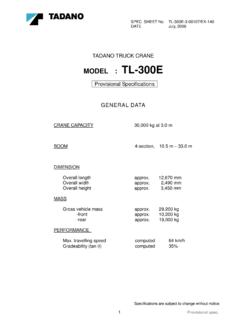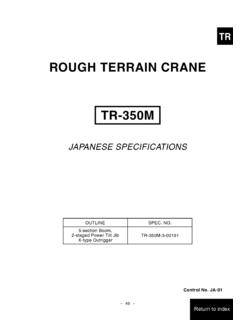Transcription of Biomechanics of Elderly Gait - ISPO Canada
1 Biomechanics of Elderly GaitEdward Lemaire, PhDThe Rehabilitation Centre (The Ottawa Hospital)University of Ottawa, Physical Medicine & RehabThe situation .. 8% of North Americans have a mobility disability (90 million in NA & Europe) Over 23% of Elderly Canadians have a mobility disability Climbs to for people over 75 years Estimate of million seniors by 2021 Over million Canadian seniors with mobility disability by 2021 Factors Affecting Locomotion Loss of muscle mass, strength, power Greater in females (25-54% lower peak power and torque) Males lose 20% strength by 65 years Decreased joint RoM 25-25% reduction up to 65 years, little change after 65 years Decreased reaction time Decreased acuity for auditory vestibular, visual, somatosensory Cognitive deficitsDiagnoses Contributing to gait Disorders Frontal gait disorder (20-28%)
2 Normal-pressure hydrocephalus (4%) Multiple strokes / Binswanger s disease (16-28%) Sensory imbalance (4-18%) Neuropathy (3-4%) Multiple sensory deficits (18%) Myelopathy (16-24%) Cervical sponylosis (22%) Vitamin B12 deficiency (16%) Parkinsonism (9-12%) Idiopathic Parkinson s disease (8%) Drug-induced parkinsonism Progressive supranuclear palsy (2%) Cerebral atrophy (8%) Tumors (2-6%) Depression (2%) Motor neuron disease (2%) Lumbar stenosis (2%) Alzheimer s disease (4%) Degenerative joint disease / gouty arthritis (4-43%) Orthostatic hypotension (2-9%) Intermittent claudication (6%) Post-cerebrovascular accident (6%) Congenital deformity (6%) Post-orthopedic surgery (3%) Vertebrobasilar insufficiency (3%) Heart disease / heart failure (2-3%) Toxic/metabolic encephalopathy (2%)Diagnoses Contributing to gait DisordersNeil Alexander, 1996 Complexity Stride Parameters Velocity decreases with age Decreased stride length, cadence Age accounts for 30-45% of walking velocity variation Height a factor for decreased velocity speed decreases per year Increases stance time, double support Deceased stride symmetryAgeVelocity (m/s)AgeVelocity (m/s) Kinematics Decreased RoM ( ) Decreased peak plantar flexion (13oversus 17o) Larger toe-out angle Kinetics Lower plantarflexor moment ( N/m/kg versus N/m/kg) and power ( W/kg W/kg)
3 Peak ankle power accounts for 52% of step length variance Weaker ankle plantar flexors and dorsiflexorsAnkle Reduced plantar flexion power affects swing initiation Trunk progression Trunk stabilizationChris A McGibbon, 2003 Knee: Kinematics RoM decreases (55oversus 59o) Extension angle at midstance increases decade swing phase angle decreases decade Elderly have slight knee flexion at end of swing (younger have full extension) Decreases quadriceps demand for loading Correlates with shorter step lengthKnee: Kinetics Higher energy absorption between stance and swing (50% versus 16%) Lower peak knee absorption power Could be related to walking speed Knee OA reduces knee power and has greater increase in hip eccentric energy expenditure(McGibbon and Krebs) From hyperextending the hip (passive-elastic mechanism for advancing leg into swing ) Increases load on hip cartilage, can destabilize pelvis / upper bodyHip: Kinematics RoM increases (40oversus 32o) Accommodate for increased hip extension with anterior pelvic drop Lower hip A/P accelerations ( m/s2versus m/s2) Hip contractures decrease extension angle Shorter step length, lower ankle powerHip.
4 Kinetics Compensation at hip produces higher Concentric hip powers (active extension) Angular impulse (sum of all moments) Positive work Partly due to decreased muscle strength of the ankle plantar-flexors and knee quadriceps group and/or hip muscle contractures Increased hip pull-off power Can contributes 16% to Elderly gait Differing results in literature May be related to desire for high foot clearance ( , confidence not to trip)Chris A McGibbon, 2003 Chris A McGibbon, 2003 Head / Torso Greater head A/P accelerations ( m/s2versus m/s2) Young able to attenuate head movement by 72%, Elderly by 58% .. or is head used for posture control?General Kinetics/Kinematics Lower A/P push-off force ( N/kg vs N/kg) Higher A/P & M/L limb accelerations over 60 years Dementia Shortened step length, increased double-support time, increased step-to-step variability Time to walk 30 ft predictor for persistent state of cognitive decline gait instability increases with age Energy cost of walking increases with age No direct correlation between energy cost and instability (energy cost due to multiple factors) At max pace, Elderly increase hip power but not ankle power (young increase peak power at all joints)Foot Pressure Lower pressures at heel, midfoot, hallux (Morag, Cavanagh, 1999)
5 Lower pressures medial & lateral calcaneal areas, all medial areas Elderly weight-bear on lateral side From treadmill studyHessert, et al., 2005 Stair descent Controlled fall Lower ankle stiffness from initiation to heel-off More time spent in foot-flat, entire single support phase Greater M/L body CoGdisplacement and velocity Less confidence = slower speed Less foot clearance Implications for P&O devices that limit ankle RoMKneeYoungAnkleElderlyFalls Leading cause of accidental death for Elderly over 75 years 33% of Elderly are fall prone 53% of falls due to tripping By 2020, cost of fall-related injuries wilreach billion in USAR edfern, et al., 2001 Falls Heel contact skid velocity higher ( m/s versus m/s), even with slower walking speed Increases slip potential Related to delayed and reduced hamstring muscle activation Delayed or prolonged muscle activation key element for unsafe gait Elderly have increased electromechanical delay (time from EMG to force production) Longer gait termination timeFallers: Biomechanical Profile Abnormal stride parameters Slower walking speed , stride length Unequal stepping, timing, broad base of support Smaller, more variable 1ststep Impaired lower extremity RoM Use assistive device (cane, walker, etc.)
6 Take more steps to turn 360o Greater lateral sway Balance decrease precedes changes in gait ?Fallers: Biomechanical Profile Fallers have higher peak hip extension moment in stance Fallers have lower peak hip extension moment knee flexion moment in preswing Knee power absorption in preswingKerrigan, et al. 2000 Fallers: Biomechanical Profile Delayed onset for push-off plantar flexion power an good predictor of falls? Combination of deficient dorsiflexors and continued contraction of plantarflexorsFallers: Biomechanical Profile Problems accommodating to postural perturbations ( Elderly and Parkinson's) Problems compensating for absent or disrupted sensory information Longer neural processing & response times Disorganized muscular responses / altered response strategy Muscular strength for correction insufficient Increased threshold for movement detectionElderly.
7 Obstacle avoidance Slower crossing strategy More rigid posture Shorter stride length, decreased peak hip moments Needed to compensate for decreased ability to control upper torso movement Increased variability = increased risk of obstacle contact Difficulty stepping over 8cm high obstaclesElderly: Obstacle avoidance Different strategies Increased limb elevation to ensure foot clearance Decreased swing velocity over obstacle (compensate for torso control) Increased errors at faster speedPsychosocial Implications Elderly with cautious gait tend to be More depressed More anxious Greater fear of falling Lower scores on Mini-Mental State Exam Assesses cognitive mental status Age-matched control groupReferences Alexander NB.
8 gait disorders in older adults. J Am Geriatr Soc, 1996;44(4):434-451. Giladi N, Herman T, Reider-Groswasser II, Gurevich T, Hausdorff JM. Clinical characteristics of Elderly patients with a cautious gait of unknown origin. J Neurol, 2005;252(3):300-306. Hamel KA, Cavanagh PR. Dynamic stability during stair descent in older adults. Int Soc Posture gait Res, 2003. Hausdorff JM, Nelson ME, Kaliton D, Layne JE, Bernstein MJ, Nuernberger A, Singh MAF. Etiology and modification of gait instability in older adults: a randomized controlled trial of exercise. J Appl Physiol, 2001;90:2117-2129. Hessert MJ, Vyas M, Leach J, Hu K, Lipsitz LA, Novak V. Foot pressure distribution during walking in young and old adults. BMC Geriatrics, 2005;5:8.
9 Van Iersel MB, Hoefsloot W, Munneke M, Bloem BR, Olde Rikkert MGM. Systematic review of quantitative clinical gait analysis in patients with dementia. Z Gerontol Geriat, 2004;37:27 32. Judge JO, Ounpuu S, Davis RB. Effects of age on the Biomechanics and physiology of gait . Clin Geriatr Med, 1996;12(4):659-678. Kemoun G, Thoumie P, Boisson D, Guieu JD. Ankle dorsiflexion delay can predict falls in the Elderly . J Rehabil Med, 2002;34:278 283 Kerrigan DC, Lee LW, Nieto TJ, Markman JD, Collins JJ, O Riley PO. Kinetic Alterations Independent of Walking speed in Elderly Fallers. Arch Phys Med Rehabil, 2000;81:730-735. Kovacs CR. Age-related changes in gait and obstacle avoidance capabilities in older adults: A review. J Appl Gerontology, 2005;24(1) Lark SD, Buckley JG, Bennett S, Jones DA, Sargeant AJ.
10 Joint torques and dynamic joint stiffness in Elderly and young men during stepping down. Clin Biomech, 2003;18:848-855. Lark SD, Buckley JG, Jones DA, Sargeant AJ. Knee and ankle range of motion during stepping down in Elderly compared to young men. Eur J Appl Physiol, 2004;91:287 295. Malatesta D, Simar D, Dauvilliers Y, Candau R, Borrani F, Pr faut C, Caillaud C. Energy cost of walking and gait instability in healthy 65- and 80-yr-olds, 2003;95:2248-2256. Marquis S, Moore M, Howieson DB, Sexton G, Payami H, Kaye JA, Camicioli R. Arch Neurol, 2002;59:601-606. McGibbon C. Toward a Better Understanding of gait Changes With Age and Disablement: Neuromuscular Adaptation. Exerc Sport Sci Rev, 2003;31(2):102-108. Petrofsky JS, Bweir S, Andal A, Chavez J, Crame A, Saunders J, Laymon M.




